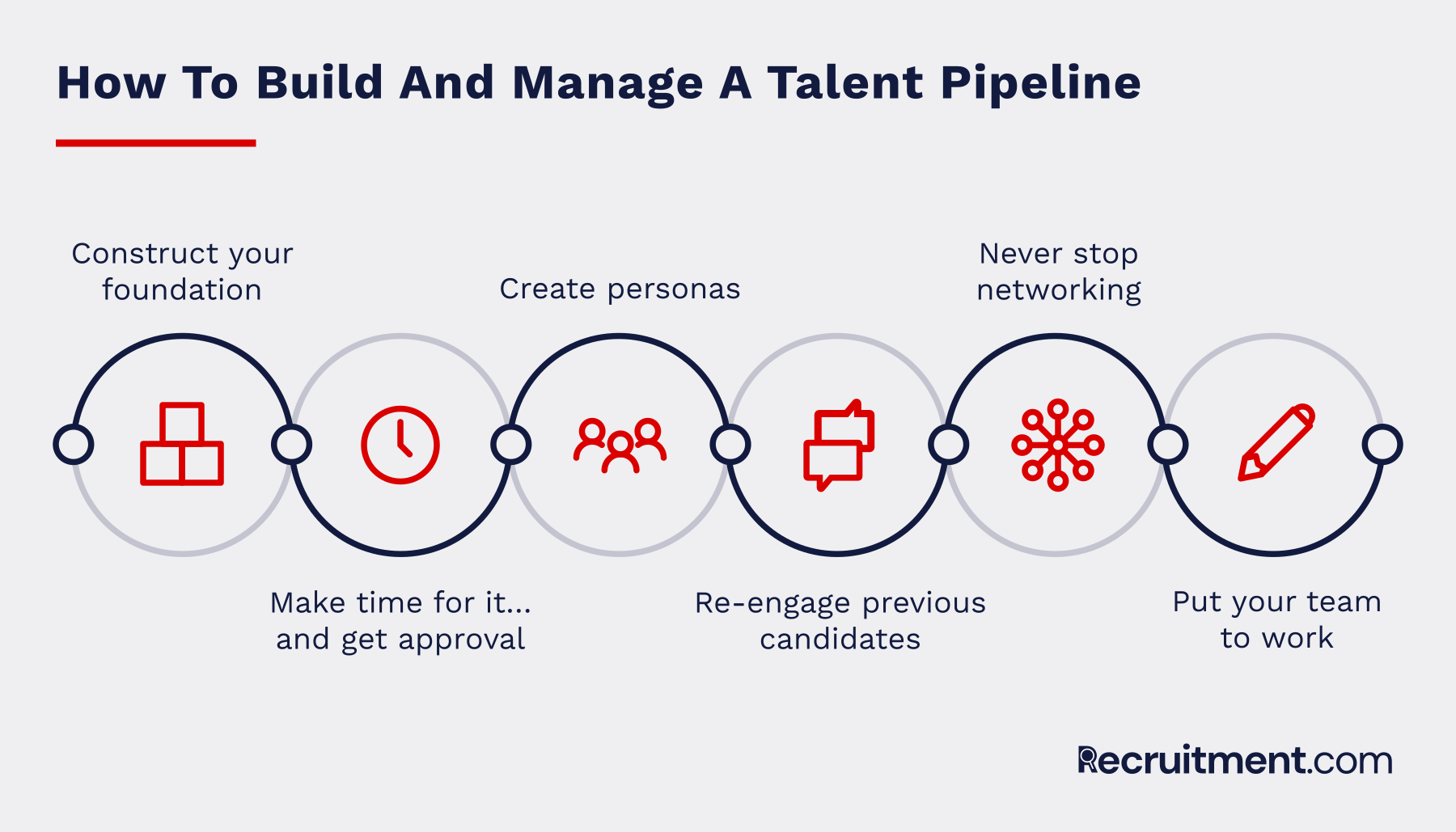What Is a Talent Pipeline and Why Is It An Overlooked Asset?

Maddie Shepherd’s work in business tech, finance, and operations has been featured in the New York Post and in HR and finance publications.
Building a robust talent pipeline is an evergreen item on a busy recruiter and hiring manager's to-do list.
But making the time to recruit gradually and proactively—a tenant of building a talent pipeline—is far from simple.
Most of the time, the hiring process and recruiting is reactive, and with good reason. Whoever your boss might be—an agency manager, a VP of People, or a group of Board Members—they would probably bristle if you focused on future talent acquisition while open roles languished.
But, just like any job, recruiting requires a balance of looking to the future and remaining present. Finding time to create a longtail talent pipeline is a concrete way to invest in your team’s future and your employer brand.
To help you elevate your talent acquisition strategy, here is a guide to creating the broadest and most qualified talent pipeline possible:
What is a talent pipeline?
A talent pipeline is a cohort of passive candidates who you have previously engaged with and who are fit to fill future roles that might open up within your company.
Talent pipelines necessarily require a proactive mindset, and creating a talent pipeline is a strategic process that relies on a deep understanding of the future of a company.
A concrete idea of what roles you will need to fill in six months, a year, five years, and beyond is crucial to create a worthwhile talent pipeline.
You might intuitively assume that creating an effective talent pipeline is less urgent than present-day role filling, but talent pipelines actually address common recruiting difficulties.
After all, 90% of employed adults hired in the past year began their job search an entire six months prior to being hired. McKinsey survey results also indicate that a third of global executives say their organization is not equipped to perform necessary replacements or training that technology will require within the next five years.
The implications of swift technological breakthroughs are notable for talent acquisition strategists: Requirements for a given position—and the skills necessary to succeed in that position—are shifting with increasing momentum.
All the while, the recruitment process is still taking up long-term windows of time. In the six months that a candidate spends searching for a job, the proficiencies required for the position you’re hiring for could look different than they did when the candidate began the job search.
This hypothetical might sound hyperbolic, but it’s meant to illustrate the ever-increasing need for an efficient, successful recruiting process. Though creating a talent pipeline might seem like a future-proofing strategy, it’s also a concrete way to address these present-day worries that some might call urgent.
Talent pipelines, pools, and communities all differ significantly
To better understand how talent pipelines work, you need to understand how they differ from talent pools and talent communities.
- Talent pipelines are talent acquisition funnels that consist of potential candidates.
- Talent pools are demographics of talent from which you must sort out qualified candidates.
- Talent communities mean that members are able to interact with each other.
Though conceptually, these groups might not differ much, in practice, they are easy to distinguish.
Consider this example:
For a recruiter who is filling a CTO position in Portland, the talent pool might be all the engineers in Portland who have managed a team and have at least 20 years’ experience.
Meanwhile, this recruiter’s talent pipeline might look like all of the qualified candidates she has spoken with in the past who are currently Portland-based or willing to relocate.
Finally, a talent community she could tap into would be a Facebook group that consisted of engineering talent in the Portland area.

How To Build And Manage A Talent Pipeline
Now that you are familiar with the intricacies of what a talent pipeline entails, take these steps to make your executing your talent pipeline a success:
Construct your talent pipeline foundations
Before you attempt to fill your talent pipeline, you need to construct some foundations—and build them well.
Much of the success of your talent pipeline efforts will rely on your employer brand. In fact, three-fourths of job seekers will consider your employer brand before they even apply for any open position with you. Marvin Smith, an HR practitioner at Lockheed Martin notes that employer branding has become more about the candidates—and what the employer can do for them—rather than the employer in and of themselves:
“The paradigm shift to the talent in control has required some major adjustments by an organization’s employer or talent branding efforts. Traditionally, the employer or talent brand has been about showcasing the organization’s image, reputation, as well as its products and services. Today, to be effective, branding messages need to be less about the organization and more about the interests and needs of the target audience.”
Moreover, first impressions matter. Any future candidates you engage today will remember your initial employer brand tomorrow. Even if that brand improves in the future when they are an active candidate, they will remember their initial impression. If that was an impression that your won’t be able to further their career, then might not be willing to consider a role with you.
Set your employer brand up well, and you will be able to attract higher-quality passive candidates into your talent pipeline funnel. Ultimately, if you initially engage passive talent with an enticing employer brand, they will be more likely to accept an offer when the time comes.
Make time for it...and get approval
Those tasked with staffing are far too often measured by their speed and conversion. As a result, taking the time to set up a talent pipeline might be a difficult pitch.
Talent pipelines, by definition, are not designed for immediacy, and those who are measuring your success need to know that you are spending time future-proofing your recruiting processes. Speak with stakeholders to come up with goals and systems for gauging how effective your talent pipeline is.
That way, your managers and colleagues can easily feel satisfied with the work you are performing.
Create talent pipeline personas
Talent pipelines are most useful when they are specialized. As a result, you should consider creating distinct talent pipelines not only based on given future roles, but also based on given candidate personas that could successfully fill each projected role.
Keep things concrete by creating a candidate persona chart for your pipeline. Create columns for each of the company goals you aim to staff for in the future. Under each goal, write down roles that will be necessary to achieving the goal. Keep space between each role for more notes. Under each role, write the demographics, skill sets, and personality traits that successful candidates would exhibit.
Based on these details, shape your personas. Of course, finding candidates that exhibit every trait, skill, and experience you listed will probably be impossible. Come up with personas that encompass typical combinations of the features you listed. These personas will help ground your efforts, even while you work within the hypothetical nature of staffing for future roles.
Plus, candidate personas will help you decide what candidate traits you aim to prioritize for each role. Mary Hogan, CEO of Red Branch Media, suggests that HR professionals prioritize personality and mindset, rather than hard skills or certifications, when crafting their candidate persona strategy:

Considering what traits will provide value to your organization will give you a candidate persona that can lead everything—from where you advertise the job to the language used in the ad itself.
CEO of Red Branch Media
Similarly, with a persona-based approach to building your talent pipeline, rather than any immediate roles, you can shape your list building, outreach, and networking strategies based on what personality traits you want to fill your team in the future.
Re-engage previous candidates
Your talent pipeline should be full of past candidates. For every would-be employee who impressed you, you should have a contact saved.
You know better than anyone: Every role requires hyper-specific traits, preferences, and skills. So, just because a given role was not right for a candidate, that does not mean your company as a whole is not a fit. Chances are, a role will cross your desk, and it will be an ideal match for a past candidate.
After all, it can take up to eight brand touchpoints to influence a desired decision—there is a good chance that a past candidacy is one of these eight interactions that could build up to a signed offer. Unless a previous candidate expressly stated they do not want to work at the company in question, keep them in your talent pipeline for future opportunities. You may also want to check with IT recruiting agencies to see how they could help in your search.
Never stop networking
Your talent pipelines will only be as big as your network. In fact, people often use “networks” and “talent pipelines” synonymously in conversation. As such, maintaining a strong and steady networking strategy as a recruiting method is absolutely crucial for talent pipeline efforts.
Not to mention, talent pipeline networking is simple—it essentially entails making new friends. Because your goals for talent pipeline networking will be less transactional than the average networker’s, you can interact with talent in a more organic way.
You should still be direct, though. You can reach out to let people know your company is always on the lookout for top talent. Once you find a message that works particularly well, you can create a template to optimize your subsequent outreach efforts.
Do not underestimate the value of attending networking events and conferences, either. In-person networking is a fundamental tactic for meeting engaged, congenial industry professionals.
Put your team to work
Finally, enlist your team to broaden your talent pipeline networking. Provide your team with the talent personas you created and request that they put you in touch with any friend or past colleague who fits the bill.
According to LinkedIn data, candidates trust employees’ take on work culture three times more than information they receive directly from the company. As a result, this referral setup will help fill your talent pipeline with passive candidates who are well-acquainted with your company and who trust your employer brand.
The value of a strong talent pipeline
You know that a talent pipeline is worth the strategy, time, and effort it requires to set up—and reading this far into the article is a testament to that knowledge. But it is worthwhile to list the most notable values of the talent pipeline model to help re-emphasize its broad benefits. In setting up a talent pipeline, beyond simply granting yourself future access to top candidates, you will also:
- Recast the recruiter as a key strategist
- Preclude a fair amount of cold calling
- Engage passive candidates in a low-stakes, non-binding way
- Exhibit culture-shaping proactivity
- Set yourself up to perform at-length culture-fit evaluations . . .
- While still streamlining the eventual recruiting process down the line
Conclusion: Build Your Talent Pipeline Model
Talent pipelines are like oil to humming talent acquisition machines. Nurturing sustained relationships with top talent will set you up for a smoother, more successful recruiting process in the future. Keep in touch with members of your talent pipeline in a meaningful way, and you will understand whether or not a candidate is a fit for a role in the future—even before they enter the formal recruiting process. Long story short, building your talent pipeline now will make you a better recruiter in the future. Let us know your 2020 talent pipeline goals and strategies in the comments below.

Maddie Shepherd’s work in business tech, finance, and operations has been featured in the New York Post and in HR and finance publications.






